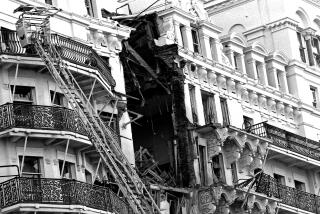Witnesses Appear on TV Show : IRA Pair Slain With Hands Up, British Told
- Share via
LONDON — Witnesses to the fatal shootings of three Irish Republican Army members by British security forces in Gibraltar last month were shown on television here Thursday night, alleging that two of those who died had their hands in the air when they were shot while a third was shot in the back.
The 50-minute, prime-time documentary, entitled “Death on the Rock” and transmitted by Thames Television, the commercial network’s London outlet, carried the accounts of five eyewitnesses to the killings on March 6.
The British government tried but failed to block transmission of the program, and in the House of Commons on Thursday, Northern Ireland Secretary Tom King labelled the documentary “trial by television.” He said it could prejudice a formal inquest scheduled in Gibraltar later this year.
The witnesses interviewed, including a British lawyer and a Spanish-English translator whose apartment overlooks the street where the shootings occurred, gave partial, but detailed accounts of the incident.
Their comments are certain to intensify the controversy surrounding the killings, one of a series of events that have strained relations between Britain and the Irish Republic in recent months.
Planning an Attack
The three who died--Mairead Farrell, 31; Daniel McCann, 30, and Sean Savage, 24--were subsequently identified by the IRA as being “on active service,” wording interpreted as meaning they were planning an attack.
They were unarmed when they died.
Both British and Spanish anti-terrorist units had reportedly collected compelling evidence that the three intended to plant a bomb at a weekly military parade in Gibraltar.
Explosives experts interviewed on Thursday’s documentary substantiated parts of Foreign Secretary Geoffrey Howe’s statement to the House of Commons on the incident. Howe asserted that “had a bomb exploded in the area, not only the 50 soldiers involved in the parade, but also a large number of civilians might well have been killed or injured.”
But eyewitnesses interviewed cast serious doubt on other portions of Howe’s statement, namely that the three were shot after they had been challenged and were making movements “which led the military personnel . . . to conclude their own lives and the lives of others were under threat.”
Mentioned No Warning
Professional translator Carmen Proetta, 42, said she watched three men dressed in jeans and jackets jump from a police car, jump across a central divider and shoot at two of the IRA members without warning as they walked toward the Spanish frontier.
“They did not say anything, did not scream or shout,” she said. “When they (the IRA members) saw these men with guns in their hands, they just put their hands up. It was like giving themselves up--an unresisting gesture.”
She and another witness said the attackers then fired at least twice at close range after the two IRA members lay on the ground. The two were identified as Farrell and McCann.
A third eyewitness said she watched the remaining IRA member shot first in the back as he attempted to flee, then shot again two or three times at point-blank range as he lay on the ground.
It is believed that the attack against the IRA unit was carried out by the British army’s Special Air Services, an elite group trained in anti-terrorist tactics, with assistance from Spanish and Gibraltar police.
Portions of the documentary provided to members of Parliament earlier in the day sparked an angry exchange in the House, with Labor’s spokesman for Northern Ireland affairs, Kevin McNamara, accusing the the government of making martyrs of those who died.
“They should have been arrested,” he claimed.
More to Read
Sign up for Essential California
The most important California stories and recommendations in your inbox every morning.
You may occasionally receive promotional content from the Los Angeles Times.









